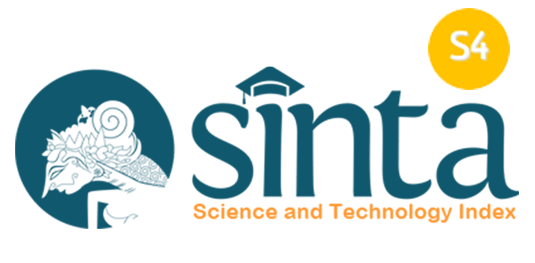Penggunaan Metode Bernyanyi dalam Menghafal Mufrodat (Kosakata) Bahasa Arab di MI
Abstract
This article aims to determine the effect of the singing method on the ability to memorize mufrodats (vocabulary) in MI Baitul Huda. This research is a quantitative research with data collection techniques in the form of written tests, questionnaires, interviews, observation and documentation. The data collection analysis used statistical analysis. Based on the results of the questionnaire answered by 22 respondents, it shows a mean with a value of 72 indicating an increase in the ability to memorize mufrodat al-fawaakih material for the experimental class students using the singing method with an average value of 90.90 while the control class with the conventional method obtained an average of 66 90. The effect of the use of the singing method on the ability to memorize mufrodates from the results of the hypothesis test can be seen that the r-count is 0.582, while the r-table is at a significant level of 1% = 0.537 and 5% = 0.423. The significance level of 1% r-count (0.582)> from the r-table (0.537), while the significant level of 5% r-count (0.582)> from the r-table (0.423). So it can be ascertained that there is a significant effect of using the singing method on the ability to memorize mufrodats.
References
Anshor, A. M. (2009). Pengajaran Bahasa Arab Media dan Metode-metodenya. Teras.
Arsyad, A. (2010). Bahasa Arab dan Metode Pengajarannya. Pustaka Pelajar.
Dewi, M. (2017). Penerapan Metode Bernyanyi untuk Meningkatkan Daya Ingat Anak dalam Pengenalan Huruf Hijaiyyah di TPA Darul Falah Gampong Pineung. UIN Ar-Raniry Darussalam Aceh.
Fajriyyah, D. F. (2019). Pengaruh Penggunaan Metode Bernyanyi terhadap Kemampuan Menghafal Mufrodat (Kosakata) pada Pembelajaran Bahasa Arab Siswa Kelas I Materi Al-Fawaakih di MI Baitul Huda Klampisan Ngaliyan Semarang Tahun Pelajaran 2018/2019. Universitas Wahid Hasyim.
Faqihuddin, A. R. (2014). Upaya Meningkatkan Penguasaan Mufrodat melalui Penerapan Metode Permainan Edukatif di Kelas VIII MTs Hidayatulloh. UIN Sunan Kalijaga Yogyakarta.
Indianto, A. (2017). Kiat-Kiat Mempertajam Daya Ingat Hafalan Pelajaran. Diva Press.
Jannah, L. A. (2013). Kesalahan-kesalahan Guru PAUD yang Sering Dianggap Sepele. Diva Press.
Kamtini, K., & Sitompul, F. A. (2020). Pengaruh Metode Bernyanyi terhadap Kemampuan Mengingat Huruf dan Angka pada Anak Usia Dini. Jurnal Obsesi : Jurnal Pendidikan Anak Usia Dini, 4(1). https://doi.org/10.31004/obsesi.v4i1.295
Maftuchah, M. (2016). Peningkatan Hasil Belajar Penguasaan Kosakata Bahasa Arab Melalui Metode Lagu Materi Al-Adawatul Madrosiyyah Tugu Semarang Tahun Ajaran 2015/2016. Universitas Wahid Hasyim Semarang.
Muna, W. (2011). Wa Muna. Teras.
Nisa, I. K., Rahmi, N., & Fajri, W. (2020). Penerapan Metode Bernyanyi dalam Meningkatkan Penguasaan Kosa Kata Bahasa Arab di MTs Ma’arif NU 07 Purbolinggo. Arabia: Jurnal Pendidikan Bahasa Arab, 12(2). https://doi.org/10.21043/arabia.v12i2.7878
Ridwan, R., & Awaluddin, A. F. (2019). Penerapan Metode Bernyanyi dalam Meningkatkan Penguasaan Mufradat dalam Pembelajaran Bahasa Arab di Raodhatul Athfal. Didaktika: Jurnal Kependidikan, 13(1). https://doi.org/10.30863/didaktika.v13i1.252
Sa’dullah. (2008). Cara Cepat Menghafal Al-Quran. Gema Insani.
Sugiyono. (2016). Metode Penelitian Kuantitatif, Kualitatif, dan R&D. Alfabeta.
Susanto, A. (2017). Pendidikan Anak Usia Dini (Konsep dan Teori). Bumi Aksara.
Triatnasari, V. (2017). Penggunaan Metode Bernyanyi dalam Meningkatkan Hasil Belajar Siswa pada Pembelajaran Matematika Kelas IIIB MIN II Bandar Lampung Tahun Pelajaran 2016/2017. UIN Raden Intan Lampung.
Yusriana, A. (2012). Kiat-kiat Menjadi Guru PAUD yang Disukai Anak-anak. Diva Press.

This work is licensed under a Creative Commons Attribution-ShareAlike 4.0 International License.
LETTER OF ORIGINALITY AND COPYRIGHT TRANSFER AGREEMENT
As an author of Dawuh Guru: Jurnal Pendidikan Guru MI/SD of PGMI Department of Tarbiyah Faculty, Institut Pesantren Mathali’ul Falah and Perkumpulan Dosen PGMI Indonesia, I, who sign below:
Declare that:
- My paper is authentic; my own writing and it has not been published/proposed in any other journals or publications.
- My paper is not plagiarism but my original idea/research.
- My paper is not written by other help, except by the Board of Editors and Reviewers recommendation who have been chosen by this journal.
- In my paper, there are no other writings or opinions except those referred to in the bibliography and relevant to the rule of writing in this journal.
- I do the transfer copyright of this paper to Dawuh Guru: Jurnal Pendidikan Guru MI.
- I make this assignment surely. If there are distortions and untruths in this assignment, later, I will take responsibility as the current law.

This work is licensed under Creative Commons Attribution-ShareAlike 4.0 International License.








